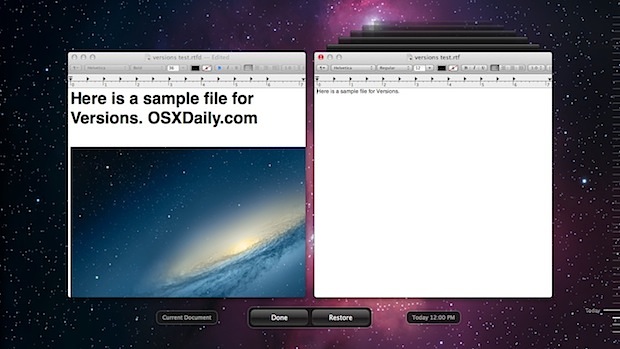Clear Versions History & Auto-Save Cache Data in Mac OS X

New versions of Mac OS X include the Versions feature and Auto-Save ability, this lets users restore back to previous editions of a file by creating a constant sequence of saved file states while they are being worked on.
All around, Versions and auto-save are useful, but they can also leave traces of sensitive documents and files you may not wish to keep around. Other than the privacy implications, this same technique can resolve some erroneous behavior with Versions as well. The simplest solution to these issues is to manually delete the Versions saved states cache directory.
Do not delete or modify these cache files unless you know exactly what you’re doing and why. You may lose data, files, or have
Accessing And Removing Versions History & Caches in OS X
The Versions cache directory is stored within the root of a Mac OS X installation here:
/.DocumentRevisions-V100/
The safest way to remove this folder will be multiple steps, so launch the Terminal (/Applications/Utilities/) and type the following:
sudo cd /
To be certain you’re about to remove the proper directory, verify the directory name:
sudo ls -l .DocumentRevisions-V100
Delete the directory and its contents with rm:
sudo rm -rf .DocumentRevisions-V100
Doing this one-time will not disable the feature, it will just remove all existing history of files that have been managed by Versions.
After a file has been processed automatically by Versions again, the directory will be rebuilt. Because this is involves editing system files and using the potentially catastrophic ‘rm -rf’ command, you shouldn’t use this tip unless you know what you’re doing and why you’re doing it.
Also, be aware that deleting the directory can cause some temporary issues with existing files that are locked or have saved states, even if file locking is turned off. Typically this will be in the form of an error message when using the file the first time, but it shouldn’t cause any serious issues.


“`
sudo cd /
“`
This accomplishes nothing worthwhile – it changes the directory to `/`, but only for the duration of the `sudo` command. When `sudo` exits, the original directory is restored.
Happily, I didn’t have to resort to this. I studied all other safe measures and after trying out some clean disk apps OnyX did the work. It cleared up all the revisions folder without me having to run the scripts above or doing it manually. It freed up 75GB in 10 minutes. I’m using Yosemite still but they offer for other systems as well. And it’s free. I had to post the comment to help others, I’ve been cracking my head in 7 pieces for the last day or so. – https://www.titanium-software.fr/en/index.html
What to do: install OnyX
Close all apps that are running
Open Onyx – it asks to run a disk check, press ok
It will look like it has frozen but it’s not
Then select tab Cleaning
Then Select tab Misc.
Then check option: Automatically saved versions of documents
Press enter
Tada!
This is the most useful of all the hints I’ve read. Versions is amazing and has saved my butt more than once, but doesn’t appear to have considered multi-gigabyte files.
With the work that I do, I run out of space once a month—killing versions is the only way I can can keep using my Mac.
Without documentation to describe how Apple is handling the Versions feature in Lion, this is a foolish hint. Guessing what a part of the System does based on a directory name is playing with a loaded gun. With the OS getting more locked down because security is a top priority, there won’t be any obvious areas to exploit
[…] Via | OSXDaily […]
you shouldn’t assume you know exactly what apple’s using that area of the system for and how it’s used. this is a stupid hint that’s just going to cause someone unforseen problems.